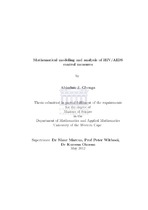| dc.contributor.advisor | Marcus, Nizar | |
| dc.contributor.advisor | Witbooi, Peter J. | |
| dc.contributor.advisor | Okosun, Kazeem | |
| dc.contributor.author | Gbenga, Abiodun J. | |
| dc.date.accessioned | 2015-03-05T08:43:06Z | |
| dc.date.available | 2015-03-05T08:43:06Z | |
| dc.date.issued | 2012 | |
| dc.identifier.uri | http://hdl.handle.net/11394/4016 | |
| dc.description | >Magister Scientiae - MSc | en_US |
| dc.description.abstract | In this thesis, we investigate the HIV/AIDS epidemic in a population which experiences a significant flow of immigrants. We derive and analyse a math-
ematical model that describes the dynamics of HIV infection among the im-
migrant youths and intervention that can minimize or prevent the spread of
the disease in the population. In particular, we are interested in the effects of
public-health education and of parental care.We consider existing models of public-health education in HIV/AIDS epidemi-ology, and provide some new insights on these. In this regard we focus atten-tion on the papers [b] and [c], expanding those researches by adding sensitivity analysis and optimal control problems with their solutions.Our main emphasis will be on the effect of parental care on HIV/AIDS epidemi-ology. In this regard we introduce a new model. Firstly, we analyse the model without parental care and investigate its stability and sensitivity behaviour.We conduct both qualitative and quantitative analyses. It is observed that
in the absence of infected youths, disease-free equilibrium is achievable and is
asymptotically stable. Further, we use optimal control methods to determine
the necessary conditions for the optimality of intervention, and for disease
eradication or control. Using Pontryagin’s Maximum Principle to check the
effects of screening control and parental care on the spread of HIV/AIDS, we
observe that parental care is more effective than screening control. However,
the most efficient control strategy is in fact a combination of parental care and screening control. The results form the central theme of this thesis, and are included in the manuscript [a] which is now being reviewed for publication.
Finally, numerical simulations are performed to illustrate the analytical results. | en_US |
| dc.language.iso | en | en_US |
| dc.publisher | University of the Western Cape | en_US |
| dc.subject | HIV | en_US |
| dc.subject | AIDS | en_US |
| dc.subject | Stability | en_US |
| dc.subject | Infected immigrants | en_US |
| dc.subject | Infectious diseases | en_US |
| dc.subject | Basic reproduction number | en_US |
| dc.subject | Diseases-free equilibrium | en_US |
| dc.subject | Endemic equilibrium | en_US |
| dc.subject | Stability analysis | en_US |
| dc.subject | Parental care | en_US |
| dc.subject | Youths | en_US |
| dc.subject | Teenagers | en_US |
| dc.subject | Optimal control | en_US |
| dc.subject | State variables | en_US |
| dc.subject | Pontryagin’s Maximum Principle | en_US |
| dc.subject | Optimality condition | en_US |
| dc.subject | Compartmental model | en_US |
| dc.title | Mathematical modeling and analysis of HIV/AIDS control measures | en_US |
| dc.type | Thesis | en_US |
| dc.rights.holder | University of the Western Cape | en_US |

